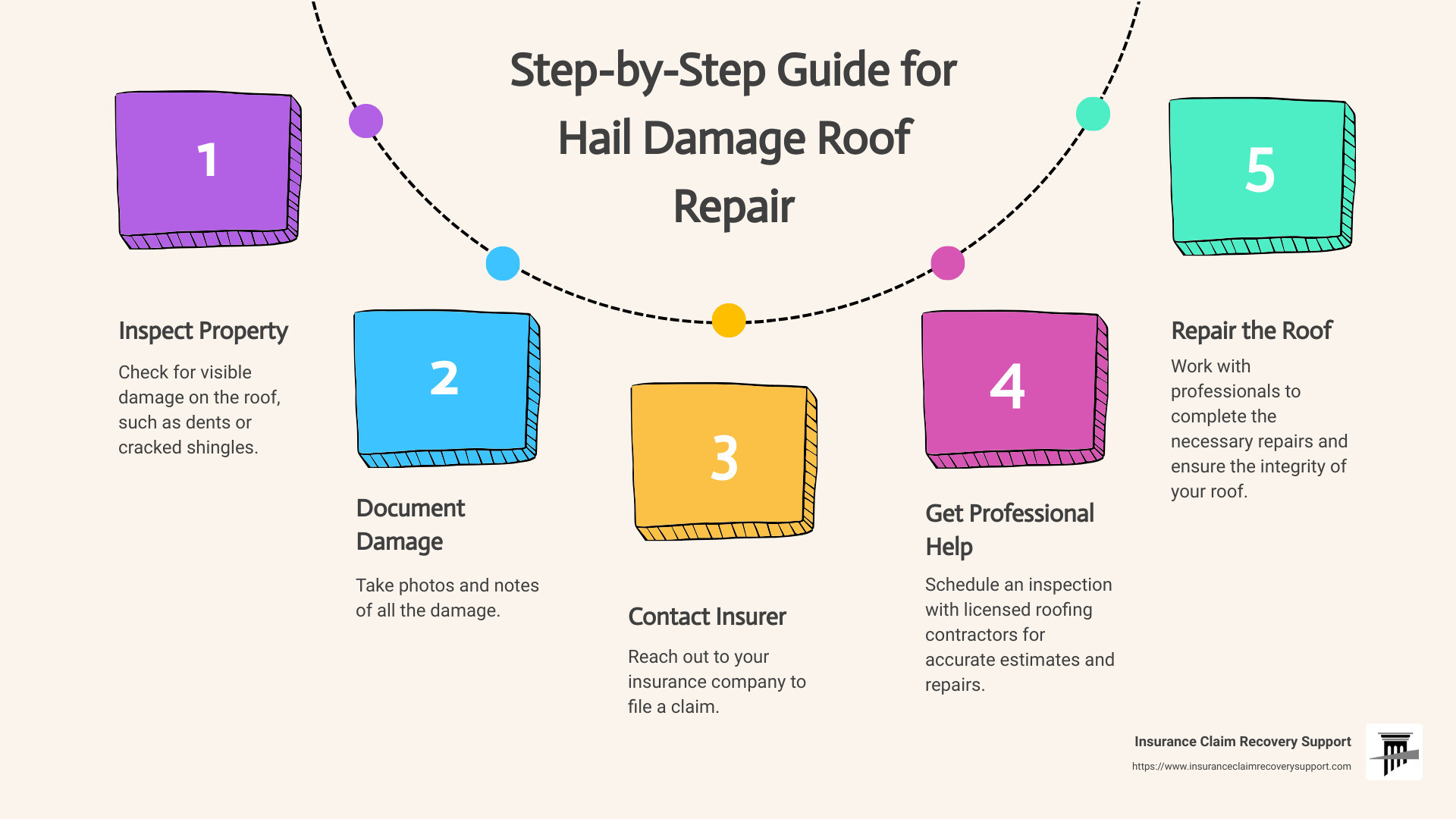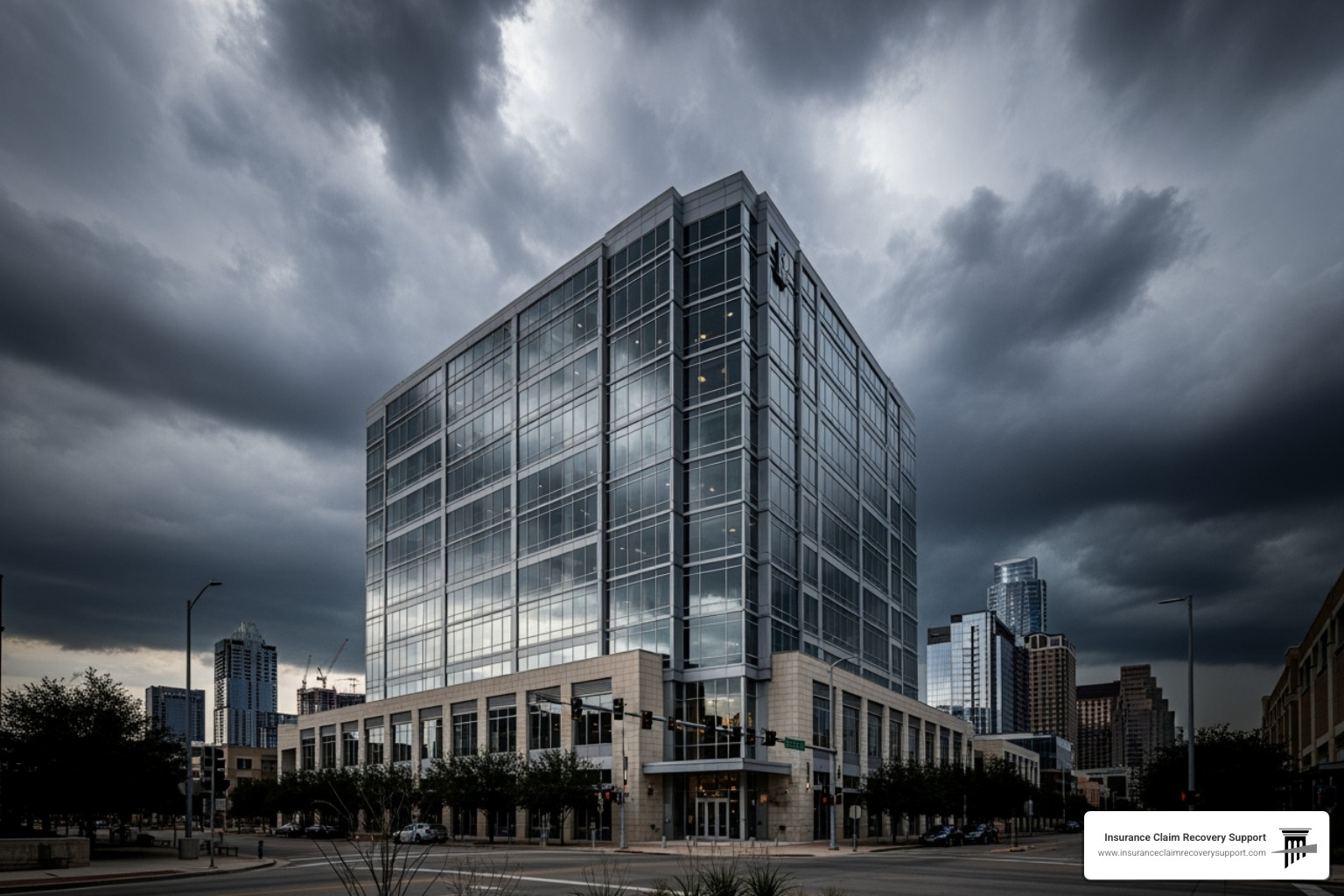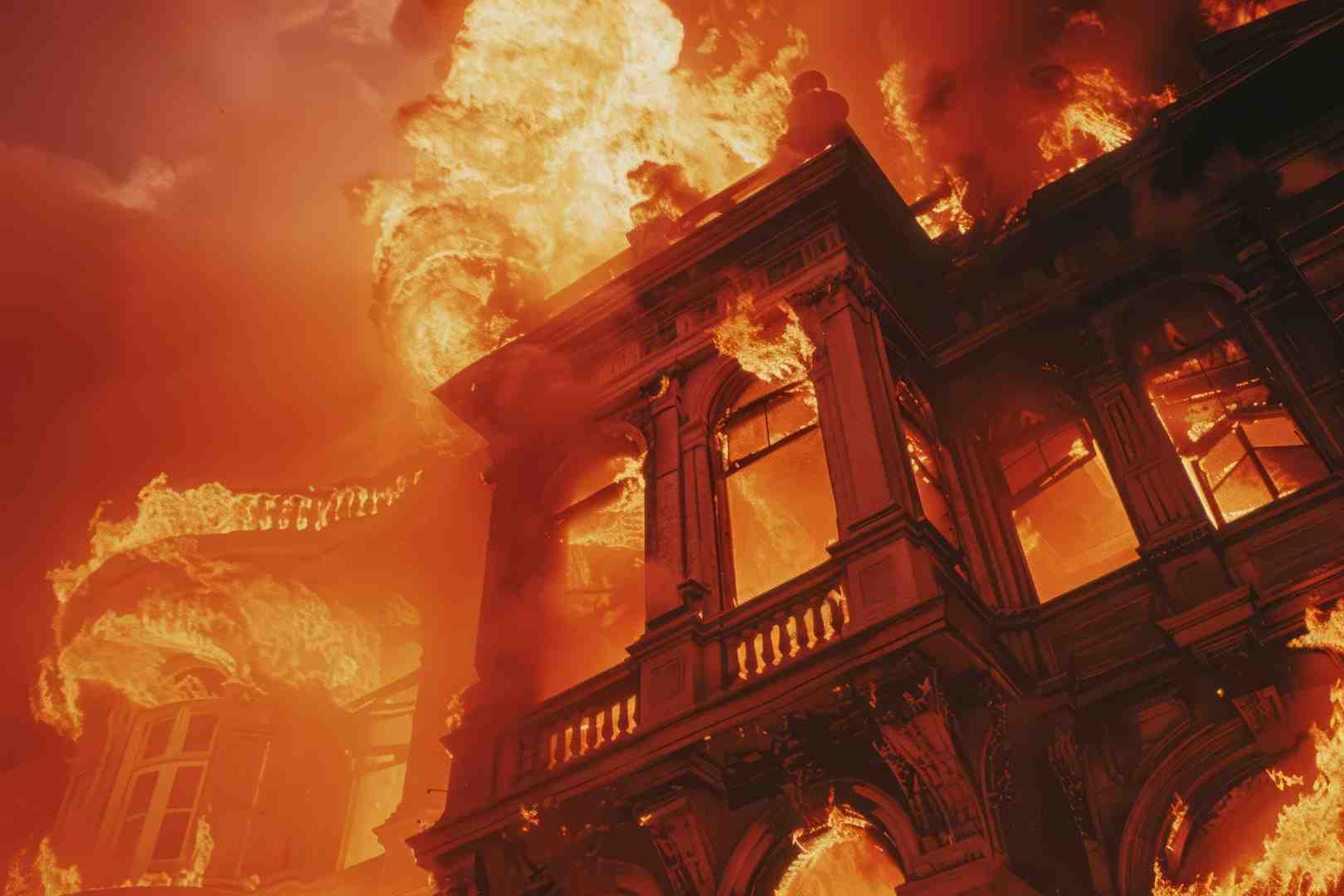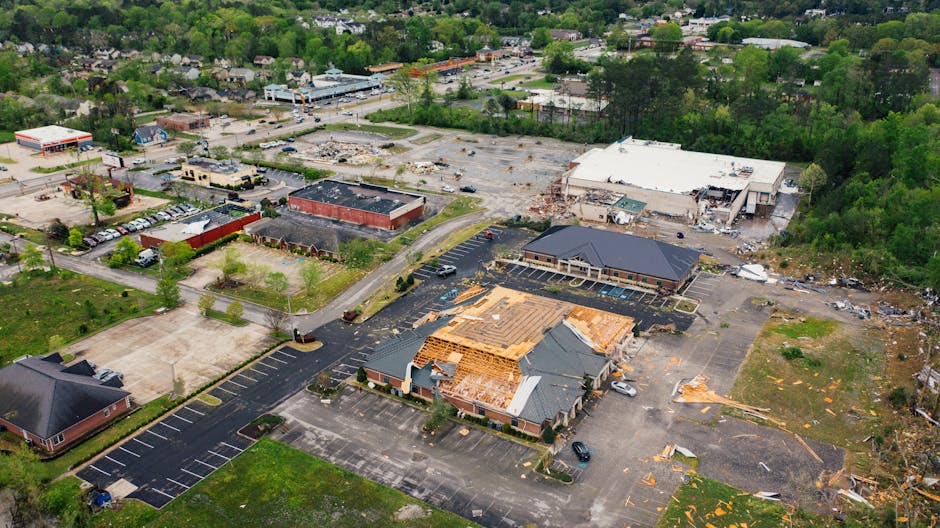Hail damage roof repair can seem daunting, but it’s essential for protecting your property and preventing further issues. If you’re dealing with hail damage, here are quick steps to follow:
- Inspect Your Property: Check for visible damage on the roof, such as dents or cracked shingles.
- Document Everything: Take photos and notes of all the damage.
- Contact Your Insurer: Reach out to your insurance company to file a claim.
- Get Professional Help: Schedule an inspection with licensed roofing contractors for accurate estimates and repairs.
Dealing with hail damage roof repair is crucial to maintaining the integrity of your building. Ignoring it can lead to more severe problems, including leaks and structural damage.
I’m Scott Friedson, a multi-state licensed public adjuster with over $250 million in settled claims. This experience helps me guide property owners through the complex world of insurance claims for issues like hail damage roof repair.

Basic hail damage roof repair terms:
– hail damage insurance claim process
– hail storm insurance claim
– hail damage covered by insurance
Assessing Hail Damage on Your Roof
After a hailstorm, it’s crucial to assess the damage to your roof thoroughly. Ignoring this can lead to more severe problems down the road, like leaks and structural issues.
Signs of Hail Damage
Visual Inspection
Start with a visual inspection. Walk around your property and look for signs of damage. Here are some things to check:
- Dents in Metal Components: Look at metal parts like flashing, vents, and gutters. Dents are a clear sign of hail damage.
- Cracked or Missing Shingles: Hail can crack shingles or even rip them off entirely. Look for shingles in your yard or your neighbor’s.
- Granule Loss: Check your gutters and downspouts for granules. Hail can knock these off your shingles, leading to exposed asphalt.
- Roof Vents and Gutters: Inspect for dents and paint chips. Damaged vents and gutters can lead to water flow issues.
- Leaks: Look inside your home for water stains or discoloration on ceilings. This could indicate a leak caused by hail damage.
Post-Storm Inspection
After a storm, it’s crucial to inspect your roof as soon as it’s safe. Be cautious:
- Roof Slope: Roofs can be steep and slippery after a storm. If you’re not comfortable inspecting it yourself, hire a professional.
- Safety Gear: If you decide to go up, use proper safety gear like a harness and non-slip shoes.
Safety Precautions
Professional Inspection
Inspecting a roof can be dangerous. It’s advisable to hire a professional roofing contractor for a thorough inspection. They have the experience and equipment to do it safely. Plus, they can spot damage that you might miss.
Documenting Damage
Take photos and videos of all visible damage. This documentation is crucial for your insurance claim. Make sure to:
- Capture close-up shots of dents, cracks, and missing shingles.
- Take wide-angle shots to show the overall condition of your roof.
- Write down notes about where and when you found the damage.
Getting Professional Help
Once you’ve documented the damage, contact a licensed roofing contractor. They can provide a detailed estimate for the repairs, which you’ll need for your insurance claim.

By following these steps, you can ensure that your hail damage roof repair process goes smoothly and effectively.
Next, we’ll dive into the steps to take after finding hail damage, including how to document it properly and how to work with your insurance company.
Steps to Take After Finding Hail Damage
After identifying hail damage on your roof, it’s important to take immediate action to mitigate further damage and start the repair process. Here’s what you should do next.
Documenting Damage
Documenting the damage is crucial for a successful insurance claim. Follow these steps:
- Photos and Videos: Take clear, close-up photos and videos of all visible damage. Capture dents, cracks, missing shingles, and any other affected areas. Include wide-angle shots to show the overall condition of your roof.
- Notes: Write detailed notes about the damage. Include the date and time you finded it, as well as the specific location of each issue.
- Keep Damaged Items: If shingles or other materials have fallen off, save them. They can serve as additional evidence for your claim.
Contacting Your Insurance Company
Once you’ve documented the damage, contact your insurance company as soon as possible. Here’s what to expect:
- Claim Process: Notify your insurer about the damage and start the claim process. Most companies have a specific time frame for filing claims, so don’t delay.
- Adjuster Inspection: Your insurance company will send an adjuster to inspect the damage. Be present during the inspection to point out all the documented issues.
- Policy Coverage: Review your policy to understand what is covered. Check if you have coverage for hail damage and whether it includes Actual Cash Value (ACV) or Replacement Cost Value (RCV).
- Deductible: Be aware of your policy’s deductible. This is the amount you’ll need to pay out-of-pocket before your insurance kicks in.
Hiring a Roofing Contractor
Choosing the right roofing contractor is essential for quality repairs. Here are some tips:
- Licensed and Certified: Ensure the contractor is licensed and certified. This guarantees they meet local regulations and industry standards.
- Experienced: Look for contractors with experience in hail damage repairs. They will be more familiar with the specific types of damage and the best repair methods.
- Local Contractors: Hiring a local contractor can be beneficial. They are more likely to understand the local climate and building codes. Plus, they’ll be easier to reach if follow-up work is needed.
- References: Ask for references and check online reviews. Speak with past clients to gauge the contractor’s reliability and quality of work.
Pro Tip: Get a detailed, written estimate from the contractor. This should include the cost of materials, labor, and any other expenses. You’ll need this for your insurance claim.
By following these steps, you can ensure that your hail damage roof repair process goes smoothly and effectively.
Next, we’ll explore the costs associated with hail damage roof repair and the factors that can affect these costs.
Hail Damage Roof Repair Costs
Repairing a hail-damaged roof can be a significant expense. Understanding the costs involved can help you budget and make informed decisions. Let’s break down the average costs, types of damage, and options for financing.
Average Cost
The average cost to repair hail damage on a roof is about $4,250. However, this can vary widely:
- Minor Damage: If you’re handy, you might fix minor damage yourself for as little as $200.
- Major Damage: Severe damage requiring a full roof replacement can exceed $32,500.
Minor Damage vs. Major Damage
Minor Damage: Small dents or cracks can often be patched up quickly. This might involve replacing a few shingles or sealing minor leaks.
Major Damage: Extensive damage might include large sections of the roof or even the entire roof needing replacement. This is more labor-intensive and costly.
DIY Repair vs. Professional Repair
DIY Repair: For minor repairs, you might handle the work yourself. This can save money but requires time and effort. Be sure to use proper safety equipment and techniques.
Professional Repair: Hiring a professional ensures that the job is done correctly. Pros have the experience and tools to handle both minor and major repairs efficiently.
Factors Affecting Repair Costs
Several factors can influence the total cost of your hail damage roof repair:
- Roof Size: Larger roofs require more materials and labor, increasing costs.
- Material: Different roofing materials have varying costs. Asphalt shingles are generally cheaper than metal or tile.
- Extent of Damage: More severe damage will naturally cost more to repair.
- Labor Costs: Labor rates vary by location and contractor. Always get multiple quotes.
- Location: Costs can vary depending on your geographical area. Areas prone to hail might have higher labor rates due to demand.
Financing Options
Repairing hail damage can be expensive, but several financing options can help:
Insurance Coverage: If your policy covers hail damage, your insurance might pay for repairs. Be sure to understand your deductible and coverage limits.
Payment Plans: Many roofing contractors offer payment plans. This allows you to spread the cost over several months or years.
Loans: Home improvement loans or personal loans can provide the funds needed for repairs. Compare interest rates and terms to find the best option.
By understanding these costs and financing options, you can better prepare for the expenses associated with hail damage roof repair.
Next, let’s dive into the insurance claims process for hail damage roof repairs.
Insurance Claims for Hail Damage Roof Repair
Navigating the insurance claims process for hail damage roof repair can feel overwhelming, but breaking it down into manageable steps can simplify the journey. Here’s what you need to know.
Common Insurance Policy Terms
Understanding your insurance policy is crucial for a successful claim. Here are some key terms:
- Actual Cash Value (ACV): This is the depreciated value of your roof. If your policy covers ACV, the payout will reflect the roof’s current worth, not its original cost.
- Replacement Cost Value (RCV): This covers the cost to replace your roof with a similar new one without considering depreciation. RCV policies generally provide higher payouts but might come with higher premiums.
- Deductible: This is the amount you pay out of pocket before your insurance kicks in. Make sure you know your deductible amount.
- Policy Limits: These are the maximum amounts your insurance will pay for a covered loss. Check if your policy has specific limits for hail damage.
Tips for a Successful Claim
To ensure you get the most out of your claim, follow these tips:
-
Detailed Documentation: Start by documenting the damage thoroughly. Take clear photos and videos of all affected areas. Note the date and time of the hailstorm, and keep any relevant weather reports.
-
Timely Filing: Report the damage to your insurance company as soon as possible. Delays can complicate the process and might even lead to a denial of your claim.
-
Professional Estimates: Obtain detailed repair estimates from reputable roofing contractors. These should be on the contractor’s letterhead and include a breakdown of labor and material costs.
-
Adjuster Inspection: An insurance adjuster will inspect the damage to determine the payout. Be present during the inspection to ensure nothing is overlooked. Provide the adjuster with all your documentation and estimates.
-
Proof of Repair: After your claim is approved and repairs are completed, you’ll need to provide proof of repair to your insurance company. This might include receipts, photos of the completed work, and a final invoice from the contractor.
-
Follow-Up: Stay in touch with your insurance company throughout the process. Keep a log of all communications, including dates, times, and the names of the representatives you speak with. This can help resolve any disputes or delays.
By understanding these terms and following these steps, you can streamline the insurance claims process and ensure a smoother experience.
Next, let’s answer some frequently asked questions about hail damage roof repair.
Frequently Asked Questions about Hail Damage Roof Repair
Should a Roof Be Replaced After Hail?
Yes, a roof often needs to be replaced after significant hail damage. Hailstones that are 1 inch or larger can cause severe dents and dings in your shingles, compromising the roof’s integrity. Even if the damage seems minor, it can shorten the lifespan of your roof and lead to leaks or other issues down the line. Always consult with a professional to assess the extent of the damage and determine if a replacement is necessary.
How Much Damage Does a Roof Need to Be Replaced?
The amount of damage required for a roof replacement isn’t just about quantity. It’s more about the size of the hail and the type of damage it causes. Hailstones that are 1 inch in diameter or larger usually cause enough damage to warrant a replacement. Look for dents in shingles, roof vents, and gutters. Insurance adjusters will inspect these areas to determine the extent of the damage. They often use “test squares” to measure the damage and decide if a replacement is necessary. Test squares are 10-foot by 10-foot sections of the roof used to assess the damage.
How Much Damage Can Hail Do to a Roof?
Hail can cause a variety of damage to your roof, including:
- Dings and Dents: These are common in metal components and can affect the aesthetic and functional integrity of your roof.
- Cracked Shingles: Hail can crack shingles, making them less effective at protecting your home from water damage.
- Punctures: Severe hail can puncture roofing materials, leading to immediate leaks and structural issues.
The extent of the damage also depends on the age and condition of your roof. Older roofs or those in poor condition are more susceptible to severe damage.

By understanding the types of damage and the criteria for roof replacement, you can make informed decisions about your hail-damaged roof.
Conclusion
Dealing with hail damage to your roof can be stressful, but you don’t have to steer it alone. At Insurance Claim Recovery Support, we specialize in representing policyholders in their insurance claims, ensuring you get the maximum settlement you deserve.
Public Adjuster Expertise
As public adjusters, we exclusively represent you, the policyholder, not the insurance company. This means we are fully committed to advocating for your rights and interests. Our team carefully documents your claim, negotiates with your insurance company, and leverages our deep understanding of hail storm insurance policies to ensure you receive the best possible outcome.
Policyholder Advocacy
We stand firmly on your side. Whether you’re a homeowner in Austin, Dallas, Fort Worth, San Antonio, Houston, Lubbock, San Angelo, Waco, Round Rock, Georgetown, or Lakeway, our mission is to support you through the entire insurance claim process. We educate you on your rights, guide you through the claims process, and provide the support you need to rebuild and recover.
Ensuring Maximum Settlement
Our unique selling proposition lies in our commitment to maximizing your insurance settlement. We’ve seen the tactics insurance companies use to lower payouts, and we counter these with thorough documentation and expert negotiation. Our approach has consistently resulted in increased settlements for our clients, turning a stressful situation into a manageable one.
Hail storms can be a frequent menace in Texas, but with the right support, you can steer the aftermath with confidence. If you’re facing a hail damage claim, don’t go it alone. Let us be your advocate, your guide, and your partner in recovery. Together, we can weather any storm.
Learn more about how we can help with your hail and wind damage insurance claims.
By understanding the types of damage and the criteria for roof replacement, you can make informed decisions about your hail-damaged roof.






